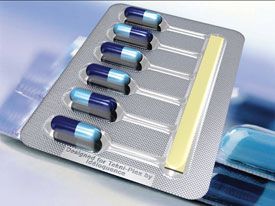To Protect and Curve
If you’ve ever opened a bottle or box of supplements, chances are you’ve touched a packaging film. Over the past few decades, packaging-material suppliers have come up with a dizzying array of options for blister packaging and shrink labeling, including polyethylene (PE), polyvinyl chloride (PVC), polyvinylidene chloride (PVdC), polychlorotrifluoroethylene (PCTFE, also known as Aclar), cyclic olefin copolymer (COC), any many others.
If you’ve ever opened a bottle or box of supplements, chances are you’ve touched a packaging film. Over the past few decades, packaging-material suppliers have come up with a dizzying array of options for blister packaging and shrink labeling, including polyethylene (PE), polyvinyl chloride (PVC), polyvinylidene chloride (PVdC), polychlorotrifluoroethylene (PCTFE, also known as Aclar), cyclic olefin copolymer (COC), any many others.

Some of the newest blister packaging films offer added protection against moisture, oxygen, and light. Additionally, new shrink labeling films are improving on earlier materials by providing more-versatile packaging and flashier graphic elements. The superior barrier properties and other useful physical characteristics of packaging films add extra layers of quality and value to natural products-improving stability as well as shelf appeal.
HIGH AND DRY
Several new blister films expand on the benefits of established packaging materials. For instance, at this year’s Interphex show, held in New York City April 24–26, Klöckner Pentaplast (Gordonsville, VA) displayed its Pentapharm alfoil SG films, an expansion of its existing line of PVdC-coated films. Intended for applications that require reliable moisture protection, SG films are available in two-layer (PVC/PVdC) or three-layer (PVC/PE/PVdC) formats.
Klöckner Pentaplast engineered the films to have several characteristics that facilitate blister-forming operations. SG materials have a low coefficient of friction, which helps them efficiently slide down packaging lines. The films also have enhanced thermoforming properties that prevent blocking on preheat plates and provide consistent material flow. Moreover, they also achieve higher filling rates by offering better mold and blister-to-blister denesting.
A special class of three-layered Pentapharm alfoil film offered by Klöckner Pentaplast is the E S03 series, manufactured in a unique PVC/PVdC/PVC structure. Like SG films, E S03 films meet high moisture- and oxygen-barrier requirements and have a low coefficient of friction. A key property of E S03 films is that they are symmetrical, enabling manufacturers to produce packages that lay flat and perform better on packaging lines. Additionally, the films are sealable to all standard vinyl-compatible lid stocks, and are available in opaque and clear colors.
“Pentapharm alfoil E S03 films were developed to offer customers a transparent alternative for pharmaceuticals requiring ultra-high moisture- and oxygen-barrier performance,” says Daniel Stagnaro, Klöckner Pentaplast’s business manager of pharmaceutical films for the Americas. “The expansion of our pharmaceutical film range to include this film, along with our existing Pentapharm PVdC, Aclar, and COC barrier films, continues to provide our customers with the broadest available selection of films for moisture-sensitive products.”
Other film suppliers are also expanding their offerings to keep up with demand for innovation in the packaging sector. In February, Tekni-Films (Flemington, NJ) announced that it had successfully completed validation of its PVdC coating line. The company’s new coating capability uses state-of-the-art technology to create clear materials with predictable barrier properties and a near absence of typical PVdC coating low lines.

Furthermore, last March, Tekni-Films unveiled Tekniflex, a modified-atmosphere blister package that combines the protection of two- or three-layer PCTFE and PE desiccant strips manufactured by CSP Technologies (Auburn, AL). Tekniflex materials incorporate the desiccants in the rib design of the blister card, preventing moisture without allowing the desiccant to come into contact with the product itself.
ADDING SHELF APPEAL
Manufacturers are increasingly using shrink films to add shelf appeal to containers, in addition to using them for blister packaging. Shrink films can enhance the look of bottles and other containers by covering up to 360° of surface area with eye-catching designs and product information. They can also cover old labels, offer evidence of tampering, provide UV protection, and wrap odd-shaped bottles.
Film School
Creating reliable blister packaging takes work-and a lot of preparation. The trial-and-error process of designing packaging can be time-consuming and expensive. However, software that helps designers study blister packaging in advance may be the stitch in time that saves nine.
BlisterPro, CAD-based software released by Klöckner Pentaplast (Gordonsville, VA) last October, enables designers, technicians, engineers, and others involved with the packaging design process to simulate the effects of tool geometry, film types, and other operational conditions before the production process begins. The program provides thickness distribution, surface area, and permeability estimates of thermoformed cavities.
“Pentapharm BlisterPro is developed to meet customer requirements for innovative technical support that gives their products a competitive and cost-effective edge,” says Daniel Stagnaro, Klöckner Pentaplast’s manager of pharmaceutical films. “Along with our existing technical capabilities and support team, this program demonstrates our commitment to the industry by providing the very best in original and creative technical solutions.”
One potential problem with shrink labeling is that films can wrap incorrectly around containers, particularly those with curvy or unconventional shapes, causing the material to generate “smile lines” on the packaging surface. Fortunately, several new shrink films are designed to address this problem, keeping smiles on the faces of manufacturers rather than on product containers.
In October 2006, Gilbreth Packaging Systems (Croydon, PA) introduced “smile-free” glycol-modified polyethylene terephthalate (PETG) wrap-around shrink labels designed for high-speed shrink-labeling machinery. Additionally, last July the company unveiled a new form of iridescent shrink film for upscale holiday products. Made with PETG and environmentally friendly polylactic acid (PLA) resins, the iridescent film presents a kaleidoscopic rainbow of colors as it reflects light. Similarly, in February, Klöckner Pentaplast extended its Pentalabel line of shrink-label films to include Pentalabel E749/52 AS7, a material for full-body shrink labels. Klöckner’s new Pentalabel film prevents smile lines by remaining consistent across the entire container surface. The film also provides strong gauge control, lay-flat characteristics, ink adhesion, and seaming ability.
“This new high-shrink Pentalabel PETG shrink-label film is developed to meet customer requirements for uniform shrinkage and brilliant graphics for narrow-neck containers,” says Jim Mullen, Klöckner Pentaplast’s manager of shrink-label films. “Along with our existing vinyl and polyester shrink-label films, we continue to provide innovation for our customers by offering the broadest selection and most cost-effective solutions in the industry.”
MORE DEMAND TO COME
According to a March 2006 report by The Freedonia Group (Cleveland), overall demand for pharmaceutical packaging products could rise 7% per year in the United States, eventually reaching $11 billion by 2010. With an annual growth rate of about 6%, blister packaging is expected to post particularly strong gains and earn the lion’s share of revenues. Shrink films are also following an upward trajectory, however. In a separate November 2005 report, The Freedonia Group predicted that U.S. demand for shrink films will rise 5.6% annually to $1.9 billion in 2009.
Thanks to their versatility, packaging films can fulfill a host of functions. The latest innovations enable films to protect delicate ingredients in blister packs and curve around unwieldy product containers. In addition, new manufacturing hardware and software can help manufacturers and product designers create more-reliable film-based packaging. Their many benefits and wide variety of potential applications make blister, shrink, and other packaging films a force to be reckoned with.
Balchem’s Newest Launch Optifolin+® Brings Innovation to the Folate Market
November 15th 2024Supplement launches featuring 5-MTHF are on the rise with double digit growth. In this episode of Nutritional Outlook’s podcast, we explore Optifolin+®, a new ingredient in the market that offers essential nutrition from prenatal through adulthood. Join us as we uncover the potential impact of the next evolution in folate, setting the stage for a healthier future.
The Nutritional Outlook Podcast Episode 35: Prioritizing Women's Health Research and Innovation
October 28th 2024On this month's episode of the Nutritional Outlook Podcast, Cepham's founder and president, Anand Swaroop, discusses the company's recent announcement to prioritize women's health research and innovation.
The Nutritional Outlook Podcast Episode 36: Best of the Industry Service Provider, Radicle Science
December 26th 2024Nutritional Outlook's managing editor, Sebastian Krawiec, interviews Radicle Science co-founders, Pelin Thorogood and Jeff Chen, MD. Radicle Science has been selected as this year's Best of the Industry, Service Provider.